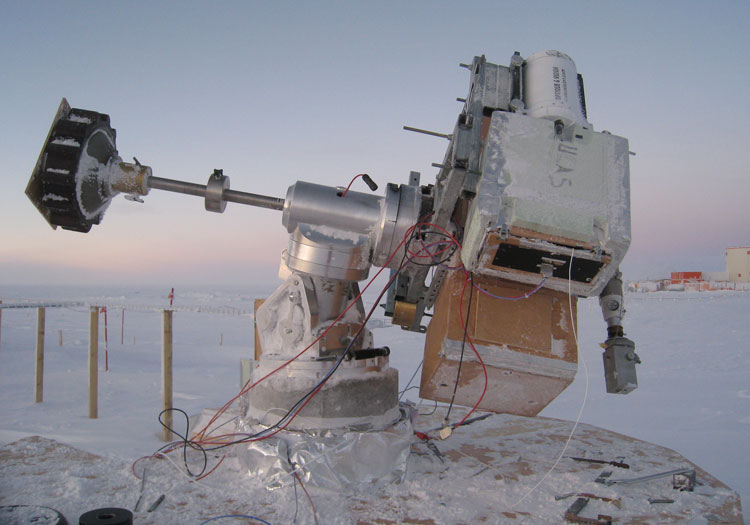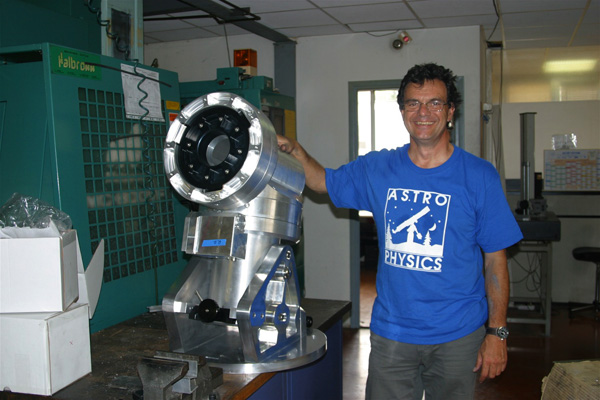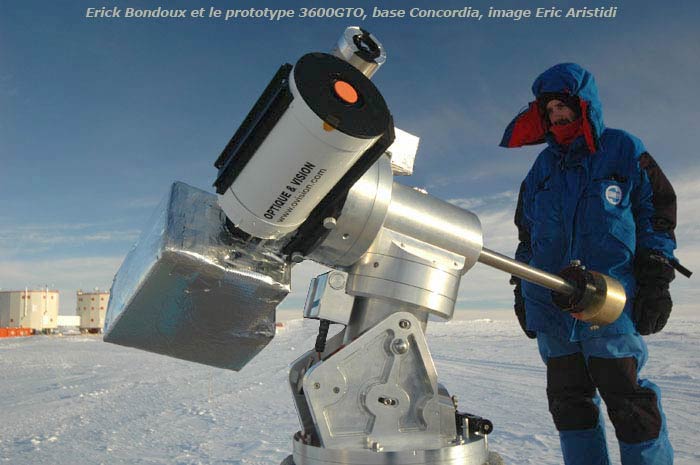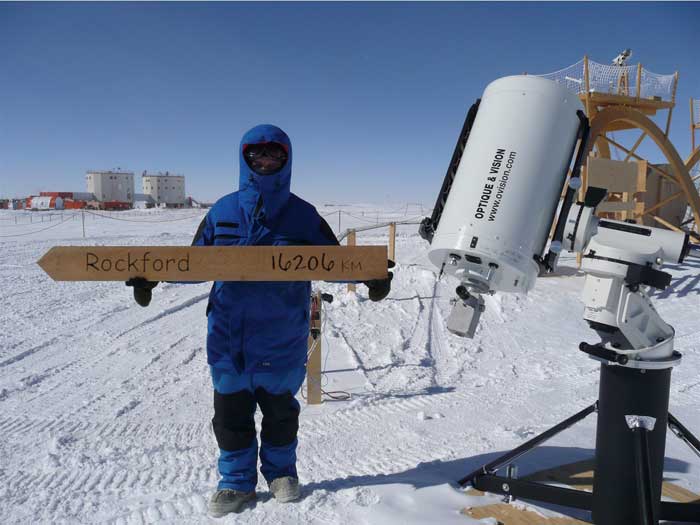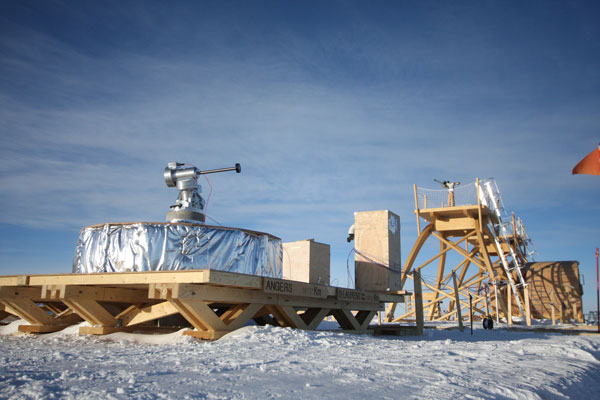April 11, 2017 Update
A second 3600GTO was installed at Concordia Station in 2010. After several years,
it returned to France when it's original
mission was complete. In late 2016, it was refurbished and returned to Concordia
to begin new research. The following article was translated from the original
French with Google Translator. The French text is below the translation.
Observation of ß Pictoris
from Antarctica: The adventure begins!
With the arrival of the Antarctic night, the observations of the ß Pic star with the ASTEP telescope have just begun. It is to observe a system of a very young star and its giant planet, to try to discover moons or rings and beyond, to solve a mystery: The variation of brightness of the star observed in Was 1981 due to the passage of the planet in front of its star? For the first time, as part of an international collaboration, a telescope will point this famous star continuously, from March to September 2017. This is possible only because this automatic telescope is located in the middle of the Antarctic continent, and That it enjoys an almost continuous night during the austral winter. The first light curves of ß Peak are very promising.
The star ß Pic is famous: it is the first star for which it was possible to image a protoplanetary disk in 1984. It is also around this star that we deduced for the first time the presence of "exocomètes ". In 2008, a planet was discovered at about 8 astronomical units of its star (roughly the distance from Saturn to the Sun). The study of this planet, ß Pic b, and the dust disk around the star, is a unique source of information to understand these very young systems and the formation of planets. As in 1981, the planet will go back in front of its star between April 2017 and January 2018. This opportunity will not recur before 18 or 36 years. The detection of a transit (the planet passing exactly in front of the star) would be a revolution in the field because it would allow for the first time to have all the physical characteristics of an exoplanet that can be directly imaged. It would also allow to observe rings, a disc around the star and / or moons, which has never been done before! However, between April and September 2017, only telescopes in Antarctica are well placed to observe ß Peak.
Thanks to the support of the Paul Emile Victor Polar Institute (IPEV),
the Côte d'Azur Observatory, the Côte d'Azur University and the Lagrange Laboratory (CNRS / OCA / Nice Sophia Antipolis University) An automated telescope capable of observing this star continuously from Concordia station in Antarctica. This station run by the Italian and French polar institutes is a permanent base: it is also inhabited during the winter, which allows the instruments to be monitored. ASTEP is an automated telescope 40cm in diameter. It is able to observe in the difficult conditions of the Antarctic: temperatures which have reached -65 ° C and which can go down to -80 ° C in the middle of the austral winter. This telescope, which was successfully operated from 2010 to 2014, was relocated to Concordia at the end of 2016, motivated by an international collaboration including the University of Grenoble and the University of Berkeley (USA). The first curves of light come to us. They are of excellent quality. Although we only have a few hours of observations, we can already see that ß Pic is actually a variable star. Its continuous monitoring will be rich in lessons. The adventure begin !
French Text
Observation de ß Pictoris depuis l’Antarctique : L’aventure commence !
Avec l’arrivée de la nuit en Antarctique, les observations de l’étoile ß Pic avec le télescope ASTEP viennent de débuter. Il s’agit d’observer un système d’une étoile très jeune et de sa planète géante, de tenter de découvrir des lunes ou des anneaux et au-delà, de résoudre un mystère : La variation de brillance de l’étoile observée en 1981 était-elle due au passage de la planète devant son étoile ? Pour la première fois, dans le cadre d’une collaboration internationale, un télescope va pointer cette étoile célèbre en continu, depuis mars jusque septembre 2017. Ceci n’est possible que parce que ce télescope automatique est localisé au milieu du continent Antarctique, et qu’il bénéficie d’une nuit presque continue lors de l’hiver austral. Les premières courbes de lumière de ß Pic sont très
prometteuses.
L’étoile ß Pic est célèbre : c’est la première étoile pour laquelle on a pu imager un disque protoplanétaire en 1984. C’est aussi autour de cette étoile que l’on a déduit pour la première fois la présence d’”exocomètes”. En 2008, une planète a été découverte à environ 8 unités astronomiques de son étoile (à peu près la distance de Saturne au Soleil). L’étude de cette planète, ß Pic b, et du disque de poussière autour de l’étoile, est une source d’information unique pour comprendre ces systèmes très jeunes et la formation des planètes. Comme en 1981, la planète va repasser devant son étoile entre avril 2017 et janvier 2018. Cette opportunité ne se reproduira pas avant 18 ou 36 années. La détection d’un transit (la planète passant exactement devant l’étoile) serait une révolution dans le domaine car elle permettrait pour la premiere fois d’avoir toutes les caractéristiques physiques d’une exoplanète qu’on peut imager directement. Elle permettrait aussi d’observer des anneaux, un disque autour de l’étoile et/ou des lunes, ce qui n’a encore jamais été fait ! Or, entre avril et septembre 2017, seuls les télescopes en Antarctique sont bien placés pour observer ß Pic.
Grâce au soutien de l’Institut polaire Paul Emile Victor (IPEV), l’Observatoire de la Côte d’Azur, l’Université Côte d’Azur et le Laboratoire Lagrange (CNRS/OCA/Université Nice Sophia Antipolis) disposent d’un télescope automatisé capable d’observer cette étoile en continu depuis la station Concordia en Antarctique. Cette station gérée par les instituts polaires italien et français est une base permanente : elle est habitée aussi l’hiver, ce qui permet un suivi des instruments. ASTEP est un télescope automatisé de 40cm de diamètre. Il est capable d’observer dans les conditions difficiles de l’Antarctique : des températures qui ont atteint -65°C et qui pourront descendre jusque -80°C au coeur de l’hiver austral. Ce télescope, qui a fonctionné avec succès de 2010 à 2014 a été réinstallé à Concordia fin 2016, motivé par une collaboration internationale incluant l’Université de Grenoble et l’université de Berkeley (USA). Les premières courbes de lumière viennent de nous parvenir. Elles sont d’excellente qualité. Bien que nous n’ayons que quelques heures d’observations, nous pouvons déjà voir que ß Pic est en fait une étoile variable. Son suivi en continu sera riche en enseignements. L’aventure
commence ! |
